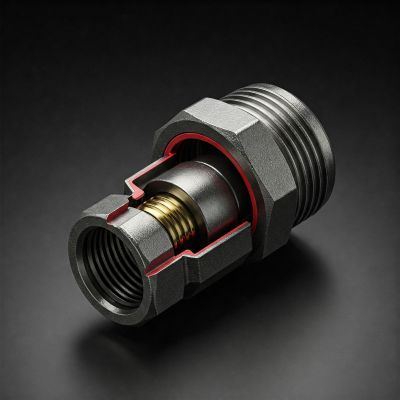Inverted flare fittings are a crucial component in fluid and gas transfer systems, providing secure, leak-free connections. These fittings are commonly used in automotive brake lines, fuel systems, plumbing applications, and hydraulic systems.
Choosing the correct size is essential for ensuring compatibility, safety, and optimal performance. This guide will help you understand inverted flare fittings, their applications, how to measure them correctly, and provide a detailed size chart to assist in selection.
What is an Inverted Flare Fitting?
An inverted flare fitting is a type of metal fitting designed to create a strong, leak-proof seal in tubing connections. It consists of a male end with a 45-degree flare that fits into a female end with a matching inverted flare seat.
Unlike standard flare fittings, inverted flare fittings have an internal (inverted) seat that provides additional sealing strength. This makes them more reliable for high-pressure applications compared to compression or push-to-connect fittings.
Benefits of Inverted Flare Fittings
➡️ Leak-proof connection: The inverted design enhances sealing.
➡️ Durability: Suitable for high-pressure applications.
➡️ Reusability: Can be disassembled and reassembled multiple times.
➡️ Corrosion resistance: Available in brass, steel, and stainless steel.
Applications of Inverted Flare Fittings
➡️ Automotive brake and fuel lines: Used in brake systems, fuel systems, and power steering lines.
➡️ HVAC and refrigeration systems: Connect refrigerant lines securely.
➡️ Hydraulic and pneumatic connections: Ideal for controlling fluid and air pressure.
➡️ Other industrial uses: Applied in gas lines, agricultural equipment, and plumbing systems.
Understanding Inverted Flare Fitting Sizes
How Fittings Are Measured
Inverted flare fittings are measured by:
➡️ Tube outside diameter (OD)
➡️ Thread size (UNF standard in most cases)
➡️ Thread pitch (threads per inch or TPI)
Standard inverted flare fittings follow the SAE (Society of Automotive Engineers) J512 standard, ensuring compatibility across different applications.
SAE vs. Other Standards
➡️ SAE Standard: Used primarily in North America for automotive and industrial applications.
➡️ Metric and BSP Standards: Found in European and Asian applications; differ in thread design.
Inverted Flare Fitting Size Chart
Below is a standard inverted flare fitting size chart:
|
Tube Size (OD) |
Thread Size (UNF) |
Hex Size |
|
3/16″ |
3/8″-24 |
7/16″ |
|
1/4″ |
7/16″-24 |
9/16″ |
|
5/16″ |
1/2″-20 |
5/8″ |
|
3/8″ |
5/8″-18 |
11/16″ |
|
1/2″ |
3/4″-16 |
7/8″ |
|
5/8″ |
7/8″-14 |
1″ |
|
3/4″ |
1-1/16″-14 |
1-1/4″ |
How to Read and Use the Chart
➡️ Identify the tube OD you are working with.
➡️ Match it with the corresponding thread size.
➡️ Use the hex size for wrench selection.
How to Choose the Right Inverted Flare Fitting
Factors to Consider
➡️ Material: Brass for corrosion resistance, steel for durability, stainless steel for high-pressure applications.
➡️ Pressure Rating: Ensure compatibility with your system.
➡️ Application: Choose the appropriate size based on automotive, hydraulic, or refrigeration needs.
Common Mistakes to Avoid
➡️ Incorrect thread selection: Always verify the thread size before installation.
➡️ Over-tightening: Can damage the flare and compromise the seal.
➡️ Using mismatched materials: Can lead to corrosion and failure.
How to Measure Fittings Accurately
➡️ Use calipers to measure tube OD.
➡️ Use a thread gauge to determine thread size and pitch.
➡️ Check manufacturer specifications for compatibility.
Installation & Maintenance Tips
Step-by-Step Installation Guide
1. Prepare the tubing: Cut and deburr the tube end.
2. Insert the nut: Place the fitting nut over the tube before flaring.
3. Flare the tube: Use a flaring tool to create a precise 45-degree flare.
4. Assemble the fitting: Connect the flared tube to the inverted flare seat.
5. Tighten securely: Use the appropriate wrench to secure the connection without over-tightening.
Best Practices for Leak-Free Connections
➡️ Ensure clean, undamaged flares before installation.
➡️ Use thread sealant if required by application.
➡️ Perform pressure testing before full operation.
Maintenance Tips
➡️ Regularly inspect for leaks.
➡️ Re-tighten fittings if necessary but avoid over-tightening.
➡️ Replace worn or damaged fittings promptly.
Frequently Asked Questions (FAQs)
What is the difference between inverted flare and regular flare fittings?
Regular flare fittings have an external flare, while inverted flare fittings have an internal flare seat for better sealing.
Can I use inverted flare fittings with any type of tubing?
No, they are designed for metal tubing such as copper, steel, and aluminum. Using plastic or rubber tubing requires adapters.
How do I prevent leaks in inverted flare connections?
➡️ Ensure the flare is smooth and free of cracks.
➡️ Use proper torque settings to avoid under- or over-tightening.
➡️ Select compatible materials to prevent corrosion.
Are these fittings reusable?
Yes, but only if they are in good condition. Replace if the flare is damaged or worn out.
Conclusion
Inverted flare fittings provide a reliable and leak-free solution for various fluid and gas transfer applications. Selecting the correct size is essential for safety and efficiency, and this guide has provided a detailed chart and key selection tips to assist you.
For accurate selection, always measure carefully and refer to the size chart. If you found this guide helpful, feel free to leave a comment or explore our recommended fitting options!
Post time: Apr-12-2025


